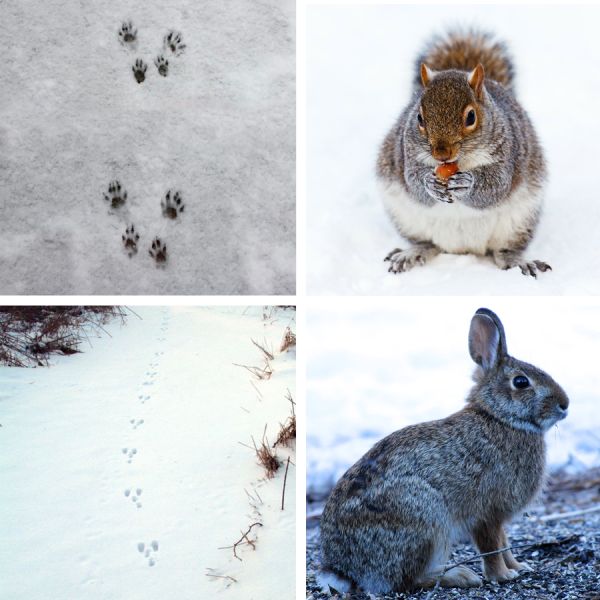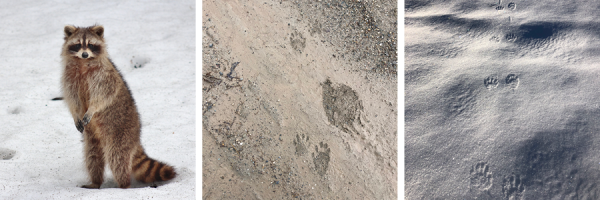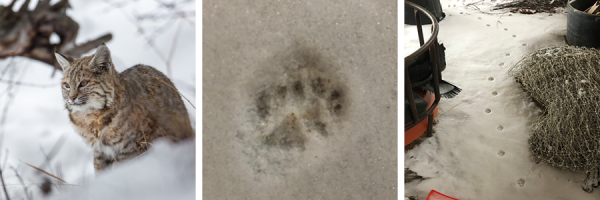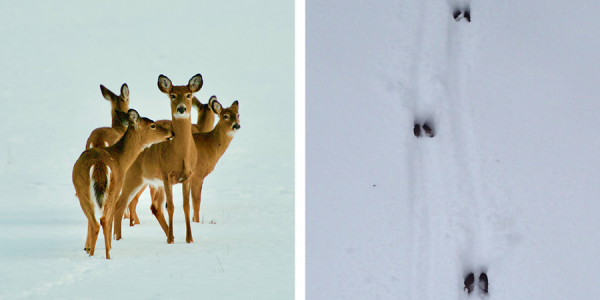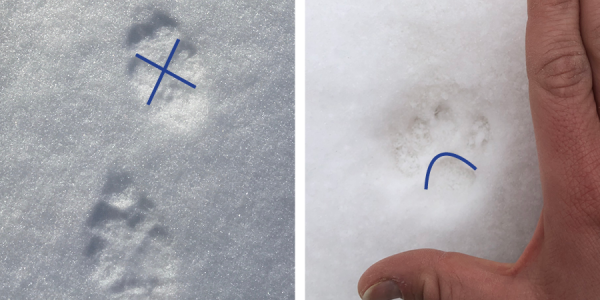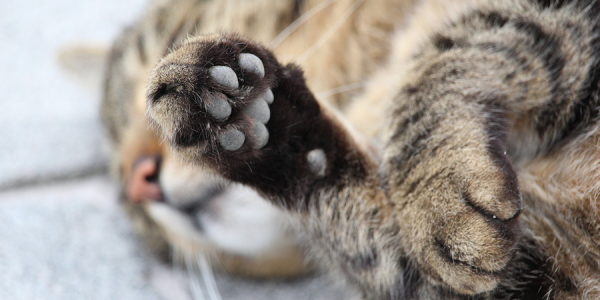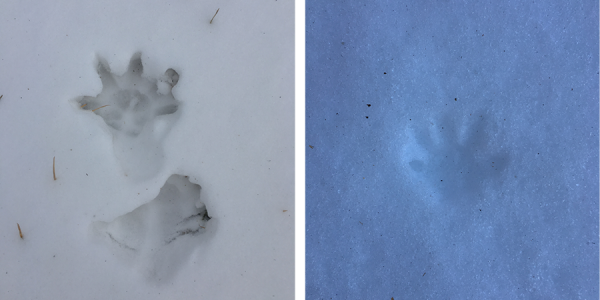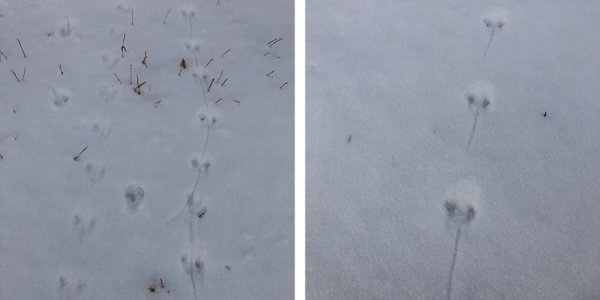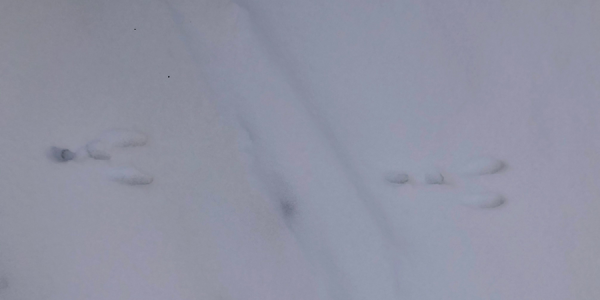Very nicely done Cat. The photos and the categories are terrific.
On my last ski outing on the Farms, a week ago, I encountered fisher tracks in two locations. One spot was east of the Duck Pond and the other was on the south side of Lone Tree. Everybody is out and about!
Thanks
Winter Wildlife Detectives: Print, Pattern & Place
This is the third part of our Winter Wildlife Detective series on our For You & Your Family blog. Check out Part One: Who’s Out There? and Part Two: Animal Clues! for more.
Finding animal tracks — whether in the snow, sand, or mud — can be very exciting. There are so many more questions to ask than just, “whose tracks are these?” I like to wonder: Where do the tracks go? Where are they coming from? Are these fresh tracks or have they been here a while? Why is this animal doing what it’s doing? How does this animal move? These are just a few questions you can use to investigate any animal tracks you find.
You can use the tracks along with surrounding clues to create your own story of what happened! Think of the “3 P’s” of tracking — Print, Pattern, and Place — when creating your own story of the secretive lives of wild animals.
Pattern
It wasn’t until I moved to Vermont, a place that often has a layer of snow on the ground throughout the winter, that I started to learn more about animal tracks. It seemed so overwhelming in the beginning, and every track looked like the next to me.
But, I learned that different groups of animals leave certain types of track patterns in the snow, which allows us to narrow down the possibilities of who it could be. Now, these patterns aren’t always exact because track patterns change depending on how fast or slow an animal is moving (just like our tracks will look different depending on whether we're taking a nice stroll or running a race!). But knowing these patterns is an excellent starting point. As you learn about the different types of movement, see if you can mimic the different styles and make different types of tracks in the snow, sand, or mud!
HOPPERS
These are animals that move by hopping. They place their front feet onto the ground and then their larger back feet swing forward. Can you think of some animals that hop? Their tracks often make this type of pattern in the snow:
Some animals that leave hopper tracks are rabbits, squirrels, and mice:
[Rabbit photo courtesy Craig Newman, rabbit tracks photo courtesy Steve Severinghaus]
WADDLERS
These are animals that tend to move one side of their bodies at a time as they walk. Often, their tracks make this type of pattern in the snow:
These animals often move slower than others, so they have what I call “superpowers” that help support them in the wild. Some super powers include:
- Opossums - prehensile tail, “playing dead,” and opposable thumbs
- Porcupines - quills
- Skunk - spray
- Raccoons - incredibly clever
See a raccoon's tracks in both mud and snow below:
STRAIGHT WALKERS
This is the category that humans would fall into. Take a walk through the snow. Do you notice how your tracks show one foot stepping in front of the other? There are animals that walk in that same way - walking with each foot stepping right in front of the other often stepping into the same track that the foot in front has made.
When you follow your grownups or friends through deep snow, do you step in the tracks that they have made? Why? Because it’s so much less work! It’s easier because it takes less energy to step into a track that’s already made than to step into deep snow. Wild animals are always finding ways to save energy in winter because they need that energy for hunting/gathering food, finding/building shelter, and staying safe from predators.
Below you can see a bobcat track direct registering: it is stepping directly into a track that it has already made. Bobcat tracks also make the straight walker pattern:
Deer tracks also make the straight walker pattern:
[DEER PHOTO COURTESY CRAIG NEWMAN, DEER TRACKS PHOTO COURTESY LARRY WADE]
Straight walkers don’t always walk in a perfectly straight line (animals need to make left and right turns, too!), but they are typically walking by putting one front in front of the other. Some examples of straight walkers besides humans are deer, fox, coyotes, and bobcats.
Remember I said that wild animals are usually saving or conserving their energy for survival? Well, pet dogs who have food, shelter, and safety provided will usually behave a bit differently than a wild coyote or fox. You may not alway see their tracks creating a straight walker pattern since they are often playing and not focused solely on their survival. There’s no need to save energy when your human is going to give you a delicious meal when you get back to your home!
Place
Where you find your animal signs tells you a lot about what animal could have possibly left the clue.
If you see a hopper track leading to a tree, and then it just vanishes... it’s likely an animal that climbs trees! Now, I would LOVE to see a rabbit climb a tree but it’s just not possible. Perhaps it’s a red or gray squirrel. They hop - check. They climb trees - check.
What if you find animal tracks out in an open field? I’ve never seen a squirrel out in a field away from the safety of the trees. It’s probably not a squirrel.
Do you have a favorite local animal? Read up on its unique behaviors! For example do you love coyotes??? Did you know that they will often leave scat (a fancy name for wild animal poop) in the middle of trails in order to mark their territory and communicate with other coyotes? See how the location of the animal clue can help you narrow down which animal it may be?
There are hundreds of prints out there and you can have a blast exploring and playing detective without learning each and every one of them. Here are a few of my favorite tricks and tips I have learned along the way:
X vs. C
At first glance, cat and dog tracks look very similar but take a closer look. Can you draw a perfect X through the track? Then, it belongs to a canid, a member of the dog family — coyotes, domestic dog, red fox, or gray fox (LEFT). Can you draw a sideways C through the track? Then, it’s a feline — a domestic cat, a feral cat, or a bobcat (RIGHT).
CLAWS OR NO CLAWS
Another trick is that claw marks are often very visible in dog tracks while they rarely show on a cat track. Do you have a pet cat? Have you noticed how they keep their claws tucked into their paw as they walk around? This is the same for wild cats like bobcats. They can bare their claws when necessary, but otherwise the claws stay retracted into their foot pad.
LOOK MA, no claws!
TRACKS LIKE STARS
Opossums have five fingers on their front feet that create tracks that look like stars or the hand of a small child. They also have opposable thumbs on their back feet which make their tracks very unique:
TAIL TRAILS
Animals with tails like mice and opossums will often leave an extra track in the snow — tail prints! — as they hop or waddle along:
TRACKS THAT LOOK LIKE LOBSTERS
Rabbit tracks remind me of lobsters... anyone agree with me? Creating your own mnemonic is very helpful!
I hope you have enjoyed learning about Vermont animals in winter and that you have a few more tools to add to your animal tracking and exploration toolkit!
Resources
- Track Patterns from Shelburne Farms' Cultivating Joy & Wonder
- Forest Animal Track Templates from Shelburne Farms' Cultivating Joy & Wonder
- Signs in the Snow from Shelburne Farms' Cultivating Joy & Wonder
- Animals on the Move from Shelburne Farms' Cultivating Joy & Wonder
- Tracks in the Snow by Wong Herbert Yee
- Our favorite waterproof tracking guide, Mammal Tracks and Scat: Life-Size Tracking Guide
- Animal Tracks by Arthur Dorros
- Tracking and Art of Seeing by Paul Rezendes

